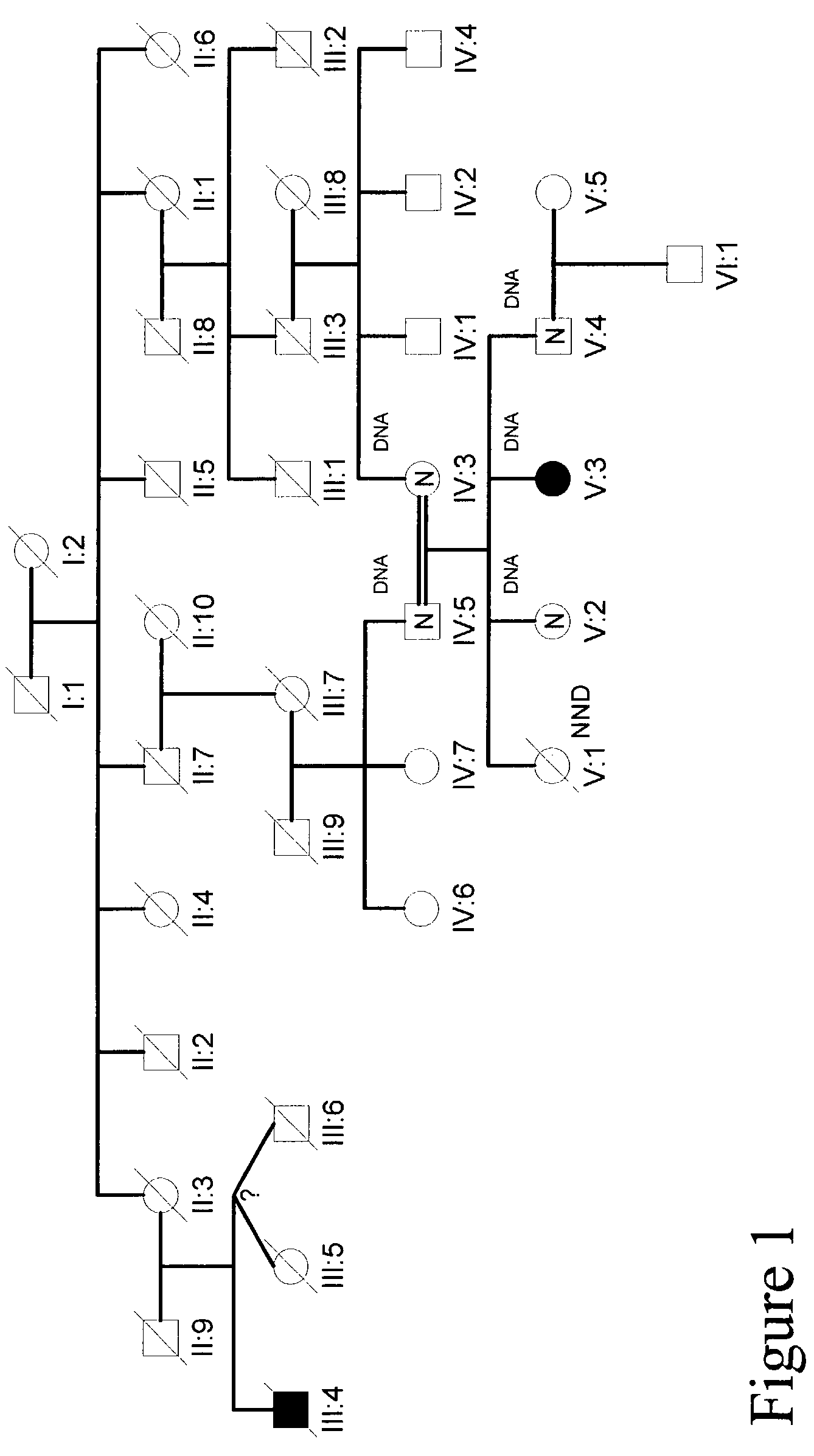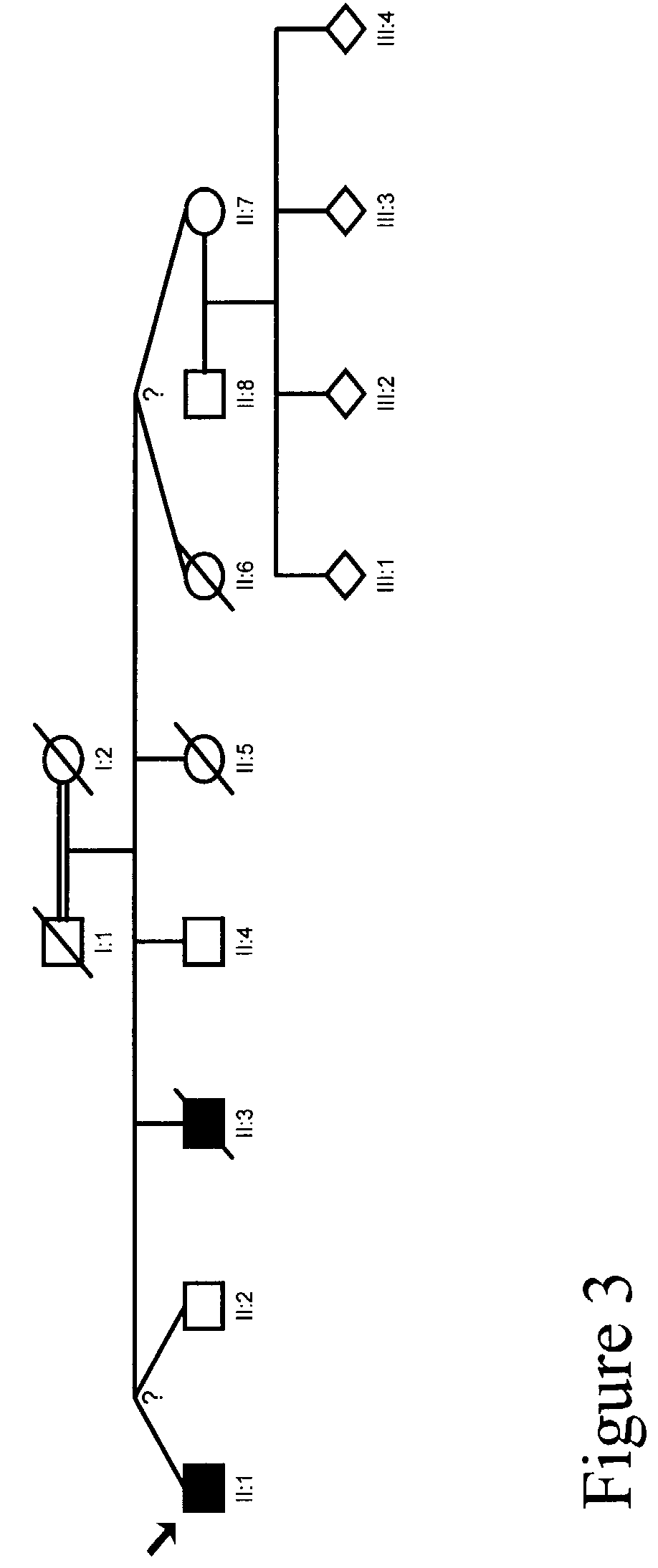Methods for identifying analgesic agents
a technology of analgesic agents and methods, applied in the field of methods for identifying analgesic agents, can solve the problems of affecting the ability of the body to synthesize prostaglandins, affecting the ability of the body to recognize common underlying genetic causes of disorders, and affecting the ability of the body to recognize common underlying genetic causes
- Summary
- Abstract
- Description
- Claims
- Application Information
AI Technical Summary
Benefits of technology
Problems solved by technology
Method used
Image
Examples
example 1
Identification of the genetic mutation responsible for Congenital Indifference to Pain (CIP) in Humans
[0219]We collected a multigenerational family with 3 affecteds (CIP-14) FIG. 1 and a smaller family with 1 affected (CIP-10) FIG. 2 reported previously (Guillermo A. and A. Grinspan. 1970. Rev Neurol (Paris) 123(6): p. 434-5.)
[0220]31 family members from CIP-14 were genotyped at 763 autosomal markers and at 48X markers. A genome-wide two-point analysis identified 8 regions with LOD scores >1.0. A region on chromosome 2 had two consecutive markers—D2S2330-D2S335—spanning 6cM, with positive scores. A LOD score of 1.51 at zero recombination was obtained at D2S2330. Multi-point analysis of this region was consistent with linkage to CIP. The CIP-14 pedigree contains 3 affecteds, one issued from a consanguineous marriage, and two expected to share one allele identical by descent with the first case and one allele identical by descent between themselves. Because the pedigree comes from an ...
example 2
RT-PCR Analysis of Relative SCN9A Expression
[0232]cDNAs from a variety of human tissues were used to perform relative quantitative RT-PCR with primers and conditions that specifically amplified the SCN9A transcript (FIG. 10). Experiments to determine the tissue distribution of SCN9A were performed with three separate primer sets. Dorsal root ganglia was included as a positive control and β-actin was included as an internal standard. We found highest levels of SCN9A relative to the β-actin standard in dorsal root ganglia and medulla oblongata. Lower levels of SCN9A product were detected in the samples from temporal lobe, thymus, hippocampus, cerebral cortex, amygdala, frontal lobe, spinal cord, occipital lobe, cerebellum, thalamus, and ovary. SCN9A expression was not detected in cDNA from parietal lobe, corpus callosum, cerebral peduncles, pons, thyroid, or placenta. The sequences of the RT-PCR products amplified from dorsal root ganglia and medulla oblongata were identical to human ...
PUM
| Property | Measurement | Unit |
|---|---|---|
| thermal | aaaaa | aaaaa |
| blood pressure | aaaaa | aaaaa |
| affinity | aaaaa | aaaaa |
Abstract
Description
Claims
Application Information
 Login to View More
Login to View More - R&D
- Intellectual Property
- Life Sciences
- Materials
- Tech Scout
- Unparalleled Data Quality
- Higher Quality Content
- 60% Fewer Hallucinations
Browse by: Latest US Patents, China's latest patents, Technical Efficacy Thesaurus, Application Domain, Technology Topic, Popular Technical Reports.
© 2025 PatSnap. All rights reserved.Legal|Privacy policy|Modern Slavery Act Transparency Statement|Sitemap|About US| Contact US: help@patsnap.com



